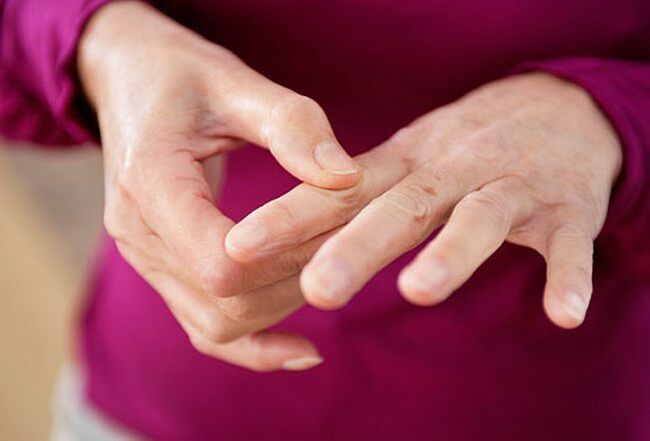
In the older age group, pain in the fingers is very common in both men and women. They are often accompanied by swelling, stiffness, and cracking when flexing or lengthening joints. Such symptoms are not only a sign of natural aging of the body, but also a clinical manifestation of various pathologies. Therefore, the cause of pain in the finger joints should be determined, and treatment should be done immediately.
Causes of pain in the finger joints
If the pain occurs weekly, then they can no longer be associated with an increase in muscle tension after long work. In the early stages of development, inflammatory or degenerative-dystrophic pathology is manifested in this way. Finger pain is associated with the gradual destruction of bone and cartilage tissue, which can lead to joint deformation, complete or partial immobilization (ankylosis).
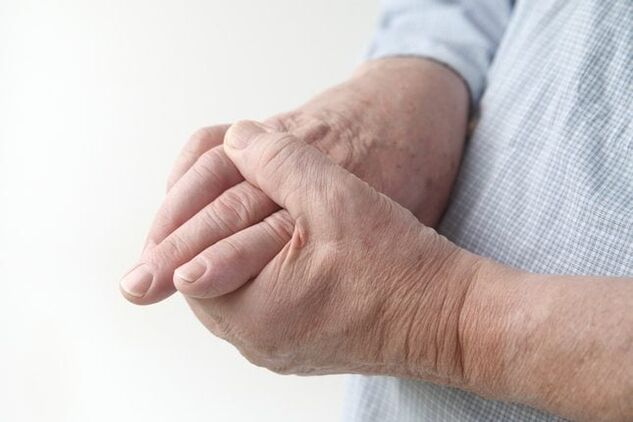
Arthritis
Finger joints in the hands can be affected by rheumatoid, reactive, psoriatic arthritis - an inflammatory, rapidly developing pathology. In addition to severe pain, inflammation is observed - redness of the skin and its swelling, limitation of movement distance. And the course of infectious arthritis is often accompanied by signs of general intoxication of the body - increased body temperature, chills, fever.
The disease is still
This is a severe autoimmune pathology, possibly developing due to an inadequate immune system response to the introduction of pathogenic microorganisms. Stationary disease doesn’t just attack small and large joints. The skin, organs of the cardiovascular and respiratory systems, and lymph nodes are damaged.
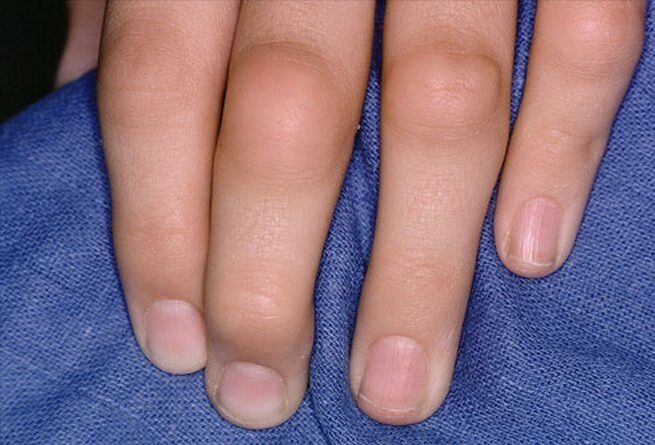
Osteoarthritis
This pathology is characterized by destruction of bone tissue with more distant joint deformation. With osteoarthritis in the morning, the fingers swell, and when you try to bend or straighten them, there is some endurance. The sharp pain appears only during the relapse period, and at the stage of remission - only discomfort.
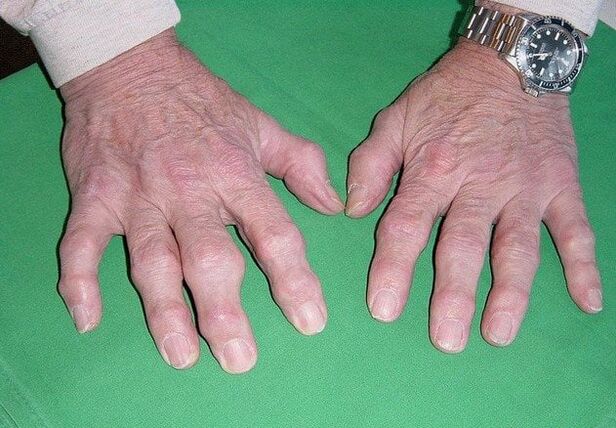
Stiginosis ligamentitis
Pathology develops due to frequent repetitive monotonous movements. Stenosing ligamentitis affects the ligament-hand apparatus of the hand, where there is blockage of the finger in an elongated or bent position. But such marked symptoms occur in the final stages of pathology, and in the early stages are indicated by pain, cracking or clicking when stretching the joint.
Gout
With gout, uric acid salt crystals begin to settle in the finger joints, provoking irritation of soft bone tissue, cartilage. The inflammatory process develops, in which ligaments, muscles, tendons are gradually involved. During a gout attack, a sharp, burning, throbbing pain. The skin on the joints swells, turns red, becomes hot to the touch.
Poliosteoarthritis
Polyosteoarthritis is a form of osteoarthritis that affects several joints at once. Cartilaginous tissue becomes thinner, thicker, and loses its protective properties. To stabilize the joint, the bone structure begins to deform, growing with the formation of osteophytes. These growths injure soft tissues, which often leads to the development of inflammatory processes.
Injuries
Pain in the finger joints can be the result of fractures, dislocations, subluxations, rupture of muscles, ligaments, tendons. A person suffers such an injury when he falls on a straight arm, a strong directional blow, or a bruise. If the victim does not seek medical help, the articular structure will coalesce in the wrong anatomical position, until the pain in the hand becomes persistent, increasing after hypothermia or a sudden change in weather.
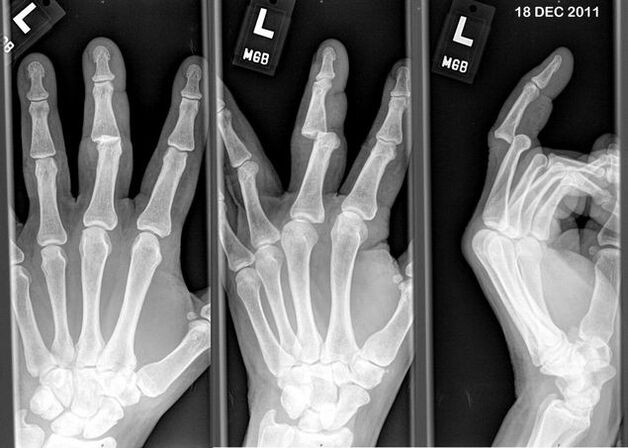
Vibration disease
This pathology develops in manual mechanic workers associated with the use of percussion instruments or rotary instruments. Clinically, vibration disease is manifested not only by uncomfortable sensations in the finger joints, but also by vascular disorders, angiospasms, circulatory disorders, and blood pressure surges.
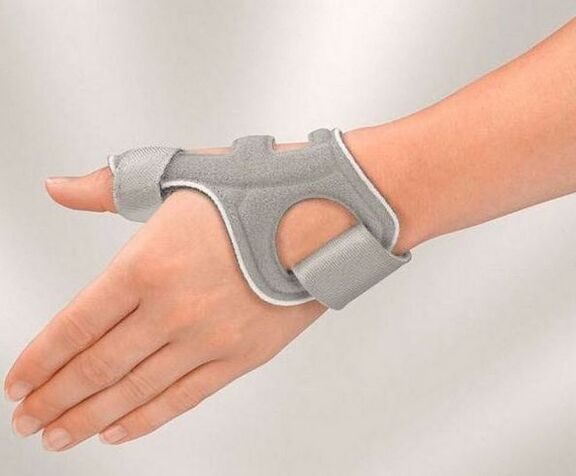
Tunnel Syndrome
The cause of the emergence of tunnel syndrome is any pathology that provokes a decrease in the volume of the carpal tunnel (arthrosis, arthritis, lipoma). The result is a compression-ischemic lesion of the median nerve. Pain occurs, sensitivity decreases, the patient complains to the doctor about the sensation of numbness, tingling sensation, crawling crawling. Any movement with the hands is accompanied by weakness, especially if you have to grab an object with your thumb.
Symptoms
Wrinkling, throbbing, sharp pain in the finger joints are the main symptoms of gouty, infectious, rheumatoid arthritis, including adolescents. The corresponding symptoms are an increase in local temperature, redness and swelling of the skin.
Arthrosis and other degenerative-dystrophic pathologies in the early stages of their development are asymptomatic. Occasionally, mild pain occurs, which disappears after a short rest. But their severity is constantly increasing. The pain is accompanied by stiffness, clicking when flexing and / or extending the finger.
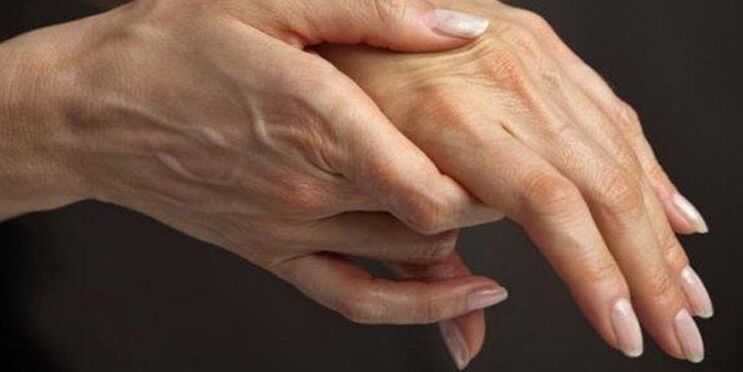
Effect
In the absence of medical intervention, the intensity of pain increases against the background of deformation of the interphalangeal joint. In the final stages of any pathology, partial or complete consolidation of the joint space occurs. A person is unable to bend or bend the fingers, which leads to loss of ability to work, disability.
The process of inflammation and destruction gradually spreads to healthy soft tissues, cartilage, and bone. Therefore, pain may be felt in some joints or fingers.
Diagnostics
The primary diagnosis is made based on external examination, patient complaints, anamnestic data, and the results of a number of functional tests. To confirm it, X-rays, MRI, CT, arthroscopy are performed. If the origin of infectious pathology is suspected, biological samples are inoculated into nutrient media to determine the type of bacteria, its resistance to antibiotics.
Treatment
To determine the tactics of therapy, the doctor (orthopedist, rheumatologist, traumatologist) takes into account the type of disease, the form of its course, the degree of tissue damage and the number of complications that have developed. Often, to reduce the severity of a patient’s pain, it is recommended to wear a soft bandage, splint or semi -rigid orthosis.
Medications
In the treatment of pathology manifested by pain in the joints of the fingers, drugs from various clinical and pharmacological groups are used. These are nonsteroidal anti-inflammatory drugs (NSAIDs), muscle relaxants, glucocorticosteroids, chondroprotectors. Also used are drugs to improve blood circulation, B vitamins, warming ointments. To relieve acute pain, intramuscular and sometimes intra-articular medication practices are practiced. The use of tablets or ointments will allow you to get rid of less obvious discomfort.
Sort
After relieving acute pain and inflammation, patients were given classical sessions, acupressure, vacuum, including hardware massage. Revitalization procedures help improve blood circulation, relieve muscle spasms, and speed the recovery of damaged tissue.
Physiotherapy
Electrophoresis procedures, ultraphonophoresis help relieve pain or get rid of it completely. During its implementation, hormonal agents, chondroprotectors, anesthetics, analgesics, B group vitamins are used. For the treatment of articular pathology, patients can also be prescribed up to 10 sessions of magnetotherapy, laser therapy, UHF therapy.
Physical training
Regular exercise therapy can strengthen the muscles of the hands quickly, preventing the development of arthrosis or arthritis. The training set is made by the training therapy doctor, taking into account the type of disease. It usually involves rotating the hands, extending the fingers, grasping and holding small objects.
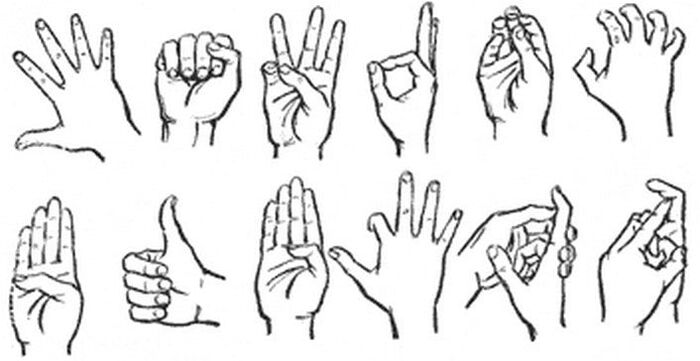
Diet
In the diet of patients with arthritis or osteoarthritis, there must be plenty of fresh ingredients, vegetables, fruits. You must exclude semi -finished products, smoked meats, fast foods, fatty meats, any alcohol from the daily menu. On the other hand, it is useful to eat rabbit meat, beef, fatty sea fish, clear soups, cereals, dairy products.
Folk remedies
After the main treatment, elimination of pain and inflammation, the doctor may allow the use of traditional medicine. During the recovery period, the use of decoctions, hand baths, homemade ointments is allowed.

The use of infusions and decoctions of herbs
The pathological course that causes pain in the fingers is often exacerbated by the deterioration of a person’s psychoemotional state. The use of herbal tea will help improve it. St. John's wort, valerian, motherwort, thyme, lemon balm, oregano have a tonic effect, calming, normalizing sleep. To prepare the drink, one teaspoon of dried plant material (without slides) is brewed with a glass of boiling water. Leave to soak for a few hours, then strain and drink 100 ml at bedtime.
Roasted onion ointment and wax
Two medium -sized peeled onions roasted until tender, grind in a mortar until flat, add a portion of 20 g of melted wax in a water bath. The resulting mass is applied to the joints, fixed with gauze bandages. The duration of the treatment procedure is 1-2 hours.
Honey and mustard ointment with herbs
Pour a teaspoon of dried calendula flowers and chamomile into a container, pour 0. 5 cups of boiling water, leave for 5 hours. Mix one teaspoon of dry mustard and fatty sour cream in a mortar, add 2 tablespoons of honey. The resulting infusion is injected in stages until a homogeneous mass is formed. Before applying the ointment, the skin is lubricated with vegetable oil.
Take a herbal bath
Put in a thermos 5 seeds of rose hips, juniper, barberry, pour a tablespoon of elecampane, St. John's wort. John, birch buds. Pour in a liter of boiling water, leave for 2 hours. Cool slightly, strain, pour into a cup, add more warm water if necessary. Dip the brush into the resulting infusion for 30 minutes.
Oil bath
Fill a small container with warm water (1. 5-2 liters), add 1-2 drops of essential oil of rosemary, eucalyptus, pine. Pour a tablespoon of cosmetic almond oil, shake. They put their hands in the water for 30-40 minutes. After the procedure, any nourishing cream or moisturizer is applied to the skin.
Straw tray
Pour 0, 5 liters of chopped oat straw into a small saucepan, pour 2 liters of hot water. Bring to a boil, simmer over low heat for 30-40 minutes. Cool to room temperature, strain. Pour the warm broth into a cup, keep the brush in it for about half an hour.
Precautions
To avoid pain in the finger joints, you should undergo a full physical examination every 6-12 months. Pathologies detected in the early stages of development usually respond well to conservative treatment. You should also avoid traumatic situations, do not smoke, limit alcohol intake, exclude foods high in fat and moderate carbohydrates from the diet.
































